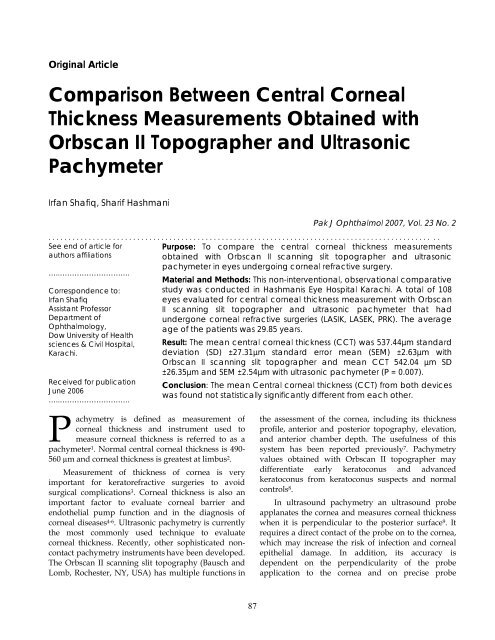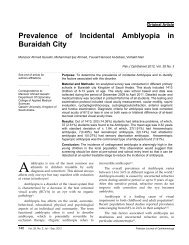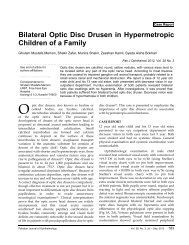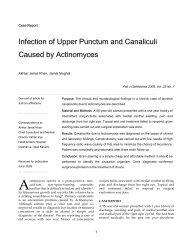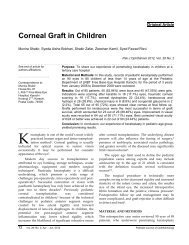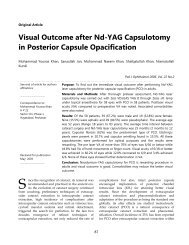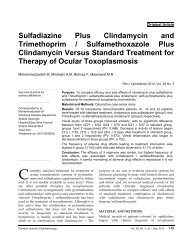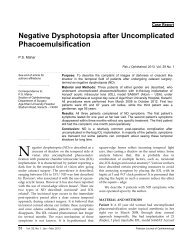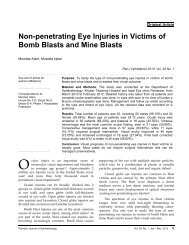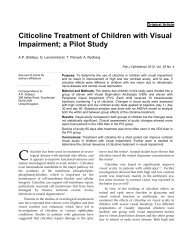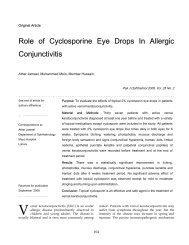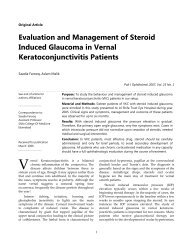Comparison Between Central Corneal Thickness Measurements ...
Comparison Between Central Corneal Thickness Measurements ...
Comparison Between Central Corneal Thickness Measurements ...
Create successful ePaper yourself
Turn your PDF publications into a flip-book with our unique Google optimized e-Paper software.
Original Article<br />
<strong>Comparison</strong> <strong>Between</strong> <strong>Central</strong> <strong>Corneal</strong><br />
<strong>Thickness</strong> <strong>Measurements</strong> Obtained with<br />
Orbscan II Topographer and Ultrasonic<br />
Pachymeter<br />
Irfan Shafiq, Sharif Hashmani<br />
Pak J Ophthalmol 2007, Vol. 23 No. 2<br />
. . . . . . . . . . . . . . . . . . . . . . . . . . . . . . . . . . . . . . . . . . . . . . . . . . . . . . . . . . . . . . . . . . . . . . . . . . . . . . . . . . . . . . . . . . . . . . . . .<br />
See end of article for Purpose: To compare the central corneal thickness measurements<br />
authors affiliations<br />
obtained with Orbscan II scanning slit topographer and ultrasonic<br />
pachymeter in eyes undergoing corneal refractive surgery.<br />
…..………………………..<br />
Correspondence to:<br />
Irfan Shafiq<br />
Assistant Professor<br />
Department of<br />
Ophthalmology,<br />
Dow University of Health<br />
sciences & Civil Hospital,<br />
Karachi.<br />
Received for publication<br />
June 2006<br />
…..………………………..<br />
Material and Methods: This non-interventional, observational comparative<br />
study was conducted in Hashmanis Eye Hospital Karachi. A total of 108<br />
eyes evaluated for central corneal thickness measurement with Orbscan<br />
II scanning slit topographer and ultrasonic pachymeter that had<br />
undergone corneal refractive surgeries (LASIK, LASEK, PRK). The average<br />
age of the patients was 29.85 years.<br />
Result: The mean central corneal thickness (CCT) was 537.44µm standard<br />
deviation (SD) ±27.31µm standard error mean (SEM) ±2.63µm with<br />
Orbscan II scanning slit topographer and mean CCT 542.04 µm SD<br />
±26.35µm and SEM ±2.54µm with ultrasonic pachymeter (P = 0.007).<br />
Conclusion: The mean <strong>Central</strong> corneal thickness (CCT) from both devices<br />
was found not statistically significantly different from each other.<br />
P<br />
achymetry is defined as measurement of<br />
corneal thickness and instrument used to<br />
measure corneal thickness is referred to as a<br />
pachymeter 1 . Normal central corneal thickness is 490-<br />
560 µm and corneal thickness is greatest at limbus 2 .<br />
Measurement of thickness of cornea is very<br />
important for keratorefractive surgeries to avoid<br />
surgical complications 3 . <strong>Corneal</strong> thickness is also an<br />
important factor to evaluate corneal barrier and<br />
endothelial pump function and in the diagnosis of<br />
corneal diseases 4-6 . Ultrasonic pachymetry is currently<br />
the most commonly used technique to evaluate<br />
corneal thickness. Recently, other sophisticated noncontact<br />
pachymetry instruments have been developed.<br />
The Orbscan II scanning slit topography (Bausch and<br />
Lomb, Rochester, NY, USA) has multiple functions in<br />
the assessment of the cornea, including its thickness<br />
profile, anterior and posterior topography, elevation,<br />
and anterior chamber depth. The usefulness of this<br />
system has been reported previously 7 . Pachymetry<br />
values obtained with Orbscan II topographer may<br />
differentiate early keratoconus and advanced<br />
keratoconus from keratoconus suspects and normal<br />
controls 8 .<br />
In ultrasound pachymetry an ultrasound probe<br />
applanates the cornea and measures corneal thickness<br />
when it is perpendicular to the posterior surface 9 . It<br />
requires a direct contact of the probe on to the cornea,<br />
which may increase the risk of infection and corneal<br />
epithelial damage. In addition, its accuracy is<br />
dependent on the perpendicularity of the probe<br />
application to the cornea and on precise probe<br />
87
placement on the corneal center 10 . Orbscan<br />
pachymetry measures corneal thickness like manual<br />
ultrasound pachymetry but it is more repeatable,<br />
simpler to perform, non-invasive and returns a map of<br />
corneal thickness rather than a point measurement. It<br />
combines a slit scanning system and a Placido disk<br />
(with 40 rings) to measure the anterior elevation and<br />
curvature of the cornea and the posterior elevation<br />
and curvature of cornea, it offers a full corneal<br />
pachymetry map with white to white measurements.<br />
Orbscan pachymetry is able to acquire over 9000 data<br />
points in 1.5 seconds and measure anterior chamber<br />
depth, angle kappa, pupil diameter, simulated<br />
keratometry readings and the thinnest corneal<br />
pachymetry reading 11 .<br />
In this study, we compared central corneal<br />
thickness measurements in prekeratorefractive surgery<br />
eyes such as Laser in-situ keratomileusis (LASIK),<br />
Laser sub-epithelial keratomileusis (LASEK) and<br />
Photorefractive keratectomy (PRK) obtained with<br />
Orbscan II scanning slit topographer (Bausch and<br />
Lomb, Rochester, NY, USA) and ultrasonic<br />
pachymetry (Pocket II Pachymeter Echo graph,<br />
Quantel Medical Inc. USA).<br />
The purpose of this study was, to compare the<br />
central corneal thickness measurements obtained with<br />
Orbscan II scanning slit topographer and ultrasonic<br />
pachymeter in eyes undergoing corneal refractive<br />
surgery.<br />
MATERIAL AND METHODS<br />
The proposed study was a non-interventional study<br />
spanning over a period of 12 months from January<br />
2005 to December 2005, conducted at Hashmanis eye<br />
hospital, Karachi. The object of this study was, to<br />
compare the central corneal thickness values from<br />
Orbscan II topographer and ultrasonic pachymeter.<br />
In this study central corneal thickness was<br />
evaluated in 108 eyes (54 right eyes, 54 left eyes) of 54<br />
subjects (21 males and 33 females) who had undergone<br />
corneal refractive surgeries (LASIK, LASEK, PRK).<br />
Data was analyzed by SPSS software and we applied<br />
paired t-test for P value.<br />
The average age of patients was 29.85 years. There<br />
was no upper age limit in this study. Patients below<br />
the age of 18 years were not included in this study.<br />
Patients with clinically significant ocular<br />
pathologic conditions (e.g. keratoconus), dry eyes,<br />
underlying autoimmune vasculopathies (e.g. lupus,<br />
rheumatoid arthritis, polyarteritis nodosa etc.),<br />
systemic diseases known to effect corneal healing,<br />
functionally monocular vision, taking medication<br />
affecting wound healing such as steroids, unable to<br />
discontinue rigid contact lenses for a minimum of 4<br />
weeks or soft contact lenses for 1 week before<br />
procedure were excluded from the study.<br />
Informed consent was obtained form all patients.<br />
All eyes were examined with scanning slit<br />
topographer and ultrasonic pachymeter.<br />
For Orbscan measurements, the patient’s chin was<br />
placed on the chin rest and the forehead was pressed<br />
against the forehead strap. The patient was asked to<br />
look at a blinking red fixation light. The examiner<br />
adjusted the optical head using a joystick to align and<br />
focus the eye so that the cornea was centered on the<br />
video monitor. The video image was then captured<br />
and measured anterior and posterior corneal elevation<br />
(relative to a best fit sphere), surface curvature and<br />
corneal thickness. Pachymetry is determined by this<br />
instrument from the difference in elevation between<br />
the anterior and posterior surface of the cornea. This<br />
instrument averages pachymetry in nine circles of<br />
2mm diameter that are located in the center of the<br />
cornea and at eight locations in the mid peripheral<br />
cornea (superior, superotemporal, temporal,<br />
inferotemporal, inferior, inferonasal, nasal,<br />
superonasal) each located 3mm form the visual axis.<br />
The Orbscan corneal topography system also<br />
determines the thinnest point on cornea and marks its<br />
distance from visual axis and its quadrant location<br />
(superotemporal, inferotemporal, superonasal and<br />
inferonasal).<br />
For ultrasonic pachymetry, measurements were<br />
taken on the table before surgery. The cornea was<br />
anaesthetised with topical proparacaine hydrochloride<br />
0.5% (Alcain) and asked the patient to look at distant<br />
object. The sterilized probe was applied as<br />
perpendicular as possible on the central cornea and<br />
three consecutive measurements were made with<br />
Pocket II. The Pocket II uses the principle of sonar<br />
(pulsed ultrasound) to measure corneal thickness. The<br />
Ultrasonic transducer makes contact with and<br />
transmits ultrasonic pulses through the surface of the<br />
cornea. Echoes are returned from the anterior and<br />
posterior surfaces of the cornea. The system measures<br />
the time between returning echoes and using the<br />
known values of the velocity of sound in the corneas<br />
and calculates the thickness.<br />
88
RESULTS<br />
Out of 54 patients included in this study, 21 patients<br />
were males and 33 patients were females. The average<br />
age was 29.85 (SD ± 8.9) years, the mean age of male<br />
patients was 27.66 and the mean age of female patients<br />
was 31.24.<br />
A total number of 108 eyes were investigated<br />
using the Orbscan II corneal topography system and<br />
ultrasonic pachymeter the mean central corneal<br />
thickness (CCT) was 537.44µm (SD ± 27.31µm)<br />
standard error mean (SEM ± 2.63µm) with Orbscan II<br />
scanning slit topographer and mean CCT 542.04 µm<br />
(SD ± 26.35µm) and SEM ± 2.54µm with ultrasonic<br />
pachymeter. P value was 0.007.<br />
In this study 21 patients (42 eyes) were males, the<br />
mean CCT was 539.69 µm with Orbscan topographer<br />
and mean CCT was 545.52 µm with ultrasonic<br />
pachymeter. 33 patients (66 eyes) were females the<br />
mean CCT was 536.0 µm with Orbscan topographer<br />
and the mean CCT was 539.82 µm with ultrasonic<br />
pachymeter.<br />
The standard deviation (SD) and standard error<br />
mean (SEM) between male and female patients<br />
obtained with Orbscan II topographer and ultrasonic<br />
pachymeter are summarized in Table.<br />
We divided all the investigated patients into three<br />
groups. In the first group we examined 19 patients (38<br />
eyes) the mean CCT was 541.9µm with Orbscan<br />
topographer and mean CCT 549.2µm with ultrasonic<br />
pachymeter. In the second group we examined 20<br />
patients (40 eyes) the mean CCT was 530.35µm with<br />
Orbscan topographer and mean CCT 538.35µm with<br />
ultrasonic pachymeter. In the third group examined<br />
patients were 15 (30 eyes) and the mean CCT was<br />
541.2µm with Orbscan topographer and mean CCT<br />
536.9µm with ultrasonic pachymeter.<br />
The standard deviation (SD) and standard error<br />
mean (SEM) among different age groups patients are<br />
summarized in Table.<br />
DISCUSSION<br />
<strong>Corneal</strong> thickness can be evaluated by number of<br />
methods including ultrasonic pachymetry 12-14 , optical<br />
slit lamp pachymetry 14 , specular microscopy 15 ,<br />
confocal microscopy 16,17 and partial coherence<br />
interferometry 18 . Each of these methods has different<br />
clinical advantages and disadvantages. Discrepancies<br />
in optical pachymetry results can be obtained by<br />
different observers or with different instruments.<br />
Ultrasonic measurement requires corneal contact and<br />
it is difficult to locate accurately the same points of<br />
measurements in serial examinations. This may result<br />
in large variation in corneal thickness measurement.<br />
The Orbscan corneal topography system is a new<br />
device to evaluate corneal thickness by measuring the<br />
anterior and posterior corneal surfaces<br />
simultaneously. It provides both anterior and<br />
posterior corneal elevation maps as well as corneal<br />
thickness data. This system produces more<br />
information about corneal thickness than ultrasonic<br />
pachymeter because it evaluates corneal thickness<br />
across the entire corneal surface and yields corneal<br />
thickness in nine different locations of cornea.<br />
In our study, the mean central corneal thickness<br />
measured by Obrscan II scanning slit topographer was<br />
slightly lesser (no statistically significant difference<br />
observed) than the mean CCT obtained by ultrasonic<br />
pachymetry, which agrees with the results as reported<br />
by Touzeau O and associates 19 .<br />
Table 1: The standard deviation (SD) and standard error mean (SEM) between male & female and among<br />
different age group patients obtained with Orbscan II topographer and ultrasonic pachymeter.<br />
Gender &<br />
Age groups<br />
Examined Orbscan II topographer Ultrasonic pachymeter<br />
No. of patient No. of eyes Mean (µm) SD (µm) SEM (µm) Mean (µm) SD (µm) SEM (µm)<br />
Male 21 42 539.69 22.56 3.48 545.52 25.79 3.98<br />
Female 33 66 536.00 30.02 3.70 539.82 26.67 3.28<br />
18-25 years 19 38 541.90 33.3 5.41 549.20 27.20 4.42<br />
26-35 years 20 40 530.35 26.63 3.74 538.35 24.54 3.88<br />
36 & above 15 30 541.20 21.77 3.98 536.90 26.05 4.76<br />
89
P= 0.007<br />
Fig. 3: Posterior best fit sphere (BFS) of left cornea<br />
from orbscan II<br />
Fig. 1: Orbscan II scanning slit topographer<br />
(Bausch and lomb, rochester, NY, USA)<br />
Fig. 4: <strong>Corneal</strong> thickness (Pachymetry) of Left eye<br />
from orbscan II<br />
Fig. 2: Anterior best fit sphere (BFS) of left cornea<br />
from orbscan II<br />
Fig. 5: Ultrasonic pachymeter (Pocket II<br />
90
Pachymeter echo graph, Quante<br />
l Medical Inc. USA)<br />
91
The pachymetry data in the present study is not<br />
consistent with previous report by Yaylali and<br />
associates who reported that measurements of the<br />
corneal thickness with the Orbscan system were 23-<br />
28µm greater (statistically significantly different) than<br />
values obtained with ultrasonic pachymeter 20 .<br />
Further studies are required to provide the exact<br />
relationship between Orbscan II scanning slit<br />
pachymetry and ultrasonic pachymeter<br />
CONCLUSION<br />
The mean <strong>Central</strong> corneal thickness (CCT) from both<br />
devices was found to be not significantly different<br />
from each other but Orbscan pachymetry is repeatable,<br />
simpler to perform, non-invasive and provides corneal<br />
thickness in nine different locations.<br />
Author’s affiliation<br />
Irfan Shafiq<br />
Assistant Professor<br />
Department of Ophthalmology,<br />
Dow University of Health sciences &<br />
Civil Hospital<br />
Karachi<br />
Sharif Hashmani<br />
Consultant Ophthalmologist<br />
Hashmani Hospital<br />
Karachi<br />
REFERENCE<br />
1. Schwab IR, Epstein RJ, Harris DJ et al. Clinical examination<br />
techniques. External disease and cornea. Basic and Clinical<br />
science course. Sec 8. San Francisco American Academy of<br />
Ophthalmology. 1996-97: 82.<br />
2. Kanski JJ. Cornea. Clinical Ophthalmology A systematic<br />
approach. 5 th ed. London: Butterworth-Heineman. 2003: 100.<br />
3. Liu Z, Huang AJ, Pflugfelder SC. Evaluation of corneal<br />
thickness and topography in normal eyes using the Orbscan<br />
corneal topography system. Br J Ophthalmol 1999; 83: 774-8.<br />
4. O'Neal MR, Polse KA. In vivo assessment of mechanism<br />
controlling corneal hydration. Invest Ophthalmol Vis Sci. 1985;<br />
26: 849-56.<br />
5. Waring GO 3d, Bourne WM, Edelhauser HF, et al. The corneal<br />
endothelium. Normal and pathologic structure and function.<br />
Ophthalmology 1982; 89: 531-90.<br />
6. Cheng H, Bates AK, Wood L, et al. Positive correlation of<br />
corneal thickness and endothelial cell loss. Serial<br />
measurements after cataract surgery. Arch Ophthalmol 1988;<br />
106: 920-2.<br />
7. Lattimore MR, Kaupp S, Schallhorn S, et al. Orbscan<br />
pachymetry: implications of a repeated measures and diurnal<br />
variation analysis. Ophthalmology 1999; 106: 977–81.<br />
8. Azar DT, Koch DD. Preoperative considerations. LASIK<br />
Fundamentals, Surgical techniques, and Complications. New<br />
York: Marcel Dakker, Inc. 2003: 153-62.<br />
9. Elkington AR, Frank HJ, Greaney MJ. Instruments. Clinical<br />
Optics. 3 rd ed. London: Blackwell Science Ltd. 1999: 208-9.<br />
10. Kawana K, Tokunaga T, Miyata K, et al. <strong>Comparison</strong> of<br />
corneal thickness mearsurments using Orbscan II, non-contact<br />
specular microscopy, and ultrasonic pachymetry in eyes after<br />
laser in situ keratomileusis. Br J Ophthalmol 2004; 88: 466-8.<br />
11. Buratto L, Brint SF. LASIK Principles and Techniques. USA:<br />
SLACK Incorporated 1998: 151-66.<br />
12. Remon L, Cristobal JA, Castillo J, et al. <strong>Central</strong> and peripheral<br />
corneal thickness in full-term newborns by ultrasonic<br />
pachymetry. Invest Ophthalmol Vis Sci 1992; 33: 3080-3.<br />
13. Argus WA. Ocular hypertension and central corneal thickness.<br />
Ophthalmology 1995; 102: 1810-12.<br />
14. Salz JJ, Azen SP, Berstein J, et al. Evaluation and comparison<br />
of sources of variability in the measurement of corneal<br />
thickness with ultrasonic and optical pachymeters. Ophthalmic<br />
Surg. 1983; 14: 750-54.<br />
15. Klyce SD, Maurice DM. Automatic recording of corneal<br />
thickness in vitro. Invest Ophthalmol. 1976; 15: 550-3.<br />
16. Lemp MA, Dilly PN, Boyde A. Tandem-scanning (confocal)<br />
microscopy of the full-thickness cornea. Cornea 1985; 4: 205-9.<br />
17. Petroll WM, Roy P, Chuong CJ, et al. Measurement of<br />
surgically induced corneal deformations using three dimensional<br />
confocal microscopy. Cornea 1996; 15: 154-64.<br />
18. Hitzenberger CK, Baumgartner A, Drexler W, et al.<br />
Interferometric measurement of corneal thickness with<br />
micrometer precision. Am J Ophthalmol. 1994; 118: 468-76.<br />
19. Touzeau O, Allouch C, Borderie V, et al. Precision and<br />
reliability of Orbscan and ultrasonic pachymetry. J Fr<br />
Ophthalmol. 2001; 24: 912-21.<br />
20. Yaylali V, Kaufman SC, Thompson HW. <strong>Corneal</strong> thickness<br />
measurements with the Orbscan Topography System and<br />
ultrasonic pachymetry. J Cataract Refract Surg. 1997; 23: 1345-<br />
50.<br />
Trabeculectomy as such or with antimetabolites like mitomycin C is still the choicest procedure in open angle<br />
glaucomas.<br />
Prof. M Lateef Chaudhry<br />
92


